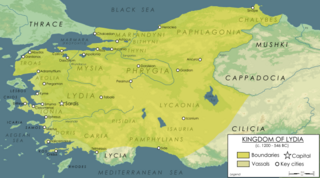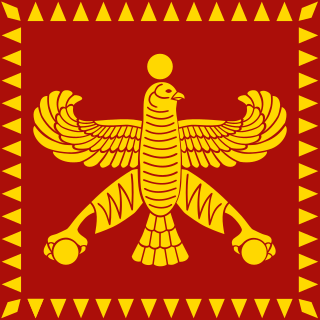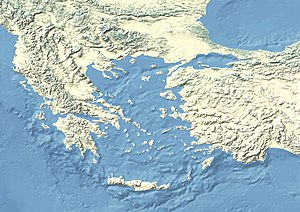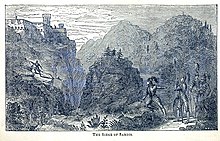
Alyattes, sometimes described as Alyattes I, was the fourth king of the Mermnad dynasty in Lydia, the son of Sadyattes, grandson of Ardys, and great-grandson of Gyges. He died after a reign of 57 years and was succeeded by his son Croesus.

Lydia was an Iron Age kingdom of western Asia Minor located generally east of ancient Ionia in the modern western Turkish provinces of Uşak, Manisa and inland Izmir. The ethnic group inhabiting this kingdom are known as the Lydians, and their language, known as Lydian, was a member of the Anatolian branch of the Indo-European language family. The capital of Lydia was Sardis.

Sardis or Sardes was an ancient city best known as the capital of the Lydian Empire. After the fall of the Lydian Empire, it became the capital of the Persian satrapy of Lydia and later a major center of Hellenistic and Byzantine culture. Now an active archaeological site, it is located in modern day Turkey, in Manisa Province near the town of Sart.

Croesus was the king of Lydia, who reigned from 585 BC until his defeat by the Persian king Cyrus the Great in 547 or 546 BC. According to Herodotus, he reigned 14 years. Croesus was renowned for his wealth; Herodotus and Pausanias noted that his gifts were preserved at Delphi. The fall of Croesus had a profound effect on the Greeks, providing a fixed point in their calendar. "By the fifth century at least", J. A. S. Evans has remarked, "Croesus had become a figure of myth, who stood outside the conventional restraints of chronology."

The Ionian Revolt, and associated revolts in Aeolis, Doris, Cyprus and Caria, were military rebellions by several Greek regions of Asia Minor against Persian rule, lasting from 499 BC to 493 BC. At the heart of the rebellion was the dissatisfaction of the Greek cities of Asia Minor with the tyrants appointed by Persia to rule them, along with the individual actions of two Milesian tyrants, Histiaeus and Aristagoras. The cities of Ionia had been conquered by Persia around 540 BC, and thereafter were ruled by native tyrants, nominated by the Persian satrap in Sardis. In 499 BC, the tyrant of Miletus, Aristagoras, launched a joint expedition with the Persian satrap Artaphernes to conquer Naxos, in an attempt to bolster his position. The mission was a debacle, and sensing his imminent removal as tyrant, Aristagoras chose to incite the whole of Ionia into rebellion against the Persian king Darius the Great.

The Greco-Persian Wars were a series of conflicts between the Achaemenid Empire and Greek city-states that started in 499 BC and lasted until 449 BC. The collision between the fractious political world of the Greeks and the enormous empire of the Persians began when Cyrus the Great conquered the Greek-inhabited region of Ionia in 547 BC. Struggling to control the independent-minded cities of Ionia, the Persians appointed tyrants to rule each of them. This would prove to be the source of much trouble for the Greeks and Persians alike.

The Battle of Lade was a naval battle which occurred during the Ionian Revolt, in 494 BC. It was fought between an alliance of the Ionian cities and the Persian Empire of Darius the Great, and resulted in a decisive victory for the Persians which all but ended the revolt.

Artaphernes, flourished circa 513–492 BC, was a brother of the Achaemenid king of Persia, Darius I, satrap of Lydia from the capital of Sardis, and a Persian general. In his position he had numerous contacts with the Greeks, and played an important role in suppressing the Ionian Revolt.

The Battle of Thymbra was the decisive battle in the war between Croesus of the Lydian Kingdom and Cyrus the Great of the Achaemenid Empire. Cyrus, after he had pursued Croesus into Lydia after the drawn Battle of Pteria, met the remains of Croesus' partially-disbanded army in battle on the plain north of Sardis in December 547 BC. Croesus' army was about twice as large and had been reinforced with many new men, but Cyrus still utterly defeated it. That proved to be decisive, and after the 14-day Siege of Sardis, the city and possibly its king fell, and Lydia was conquered by the Persians.
The Battle of Pteria was fought in 547 BC between the Persian forces of Cyrus the Great and the Lydian forces of Croesus. Both armies suffered heavy casualties in this indecisive battle.

Cyrus II of Persia, commonly known as Cyrus the Great, was the founder of the Achaemenid Persian Empire. Hailing from Persis, he brought the Achaemenid dynasty to power by defeating the Median Empire and embracing all of the previous civilized states of the ancient Near East, expanding vastly and eventually conquering most of West Asia and much of Central Asia to create what would soon become the largest polity in human history at the time. Widely considered the world's first superpower, the Achaemenid Empire's largest territorial extent was achieved under Darius the Great, whose rule stretched from the Balkans and the rest of Southeast Europe in the west to the Indus Valley in the east.

Phocaea or Phokaia was an ancient Ionian Greek city on the western coast of Anatolia. Greek colonists from Phocaea founded the colony of Massalia in 600 BC, Emporion in 575 BC and Elea in 540 BC.
Harpagos, also known as Harpagus or Hypargus, was a Median general from the 6th century BC, credited by Herodotus as having put Cyrus the Great on the throne through his defection during the battle of Pasargadae.

Mazares was a Median general who defected to Cyrus the Great when the latter overthrew his grandfather, Astyages and formed the Persian Empire. Mazares is mentioned by Herodotus as a Median general in the service of Cyrus the Great who died while putting down a revolt in Asia Minor.

The siege of Naxos was a failed attempt by the Milesian tyrant Aristagoras, operating with support from, and in the name of the Persian Empire of Darius the Great, to conquer the island of Naxos. It was the opening act of the Greco-Persian Wars, which would ultimately last for 50 years.

The Satrapy of Lydia, known as Sparda in Old Persian, was an administrative province (satrapy) of the Achaemenid Empire, located in the ancient kingdom of Lydia, with Sardis as its capital.

Tabalus the Persian ,Greek: Τάβαλος, was the first Persian satrap of Sardis. Cyrus the Great of Persia put him in place after conquering Lydia and annexing it into the Persian Empire in 546 BC. Herodotus mentions him in his histories :
Presently, entrusting Sardis to a Persian called Tabalus, and charging Pactyes, a Lydian, to take charge of the gold of Croesus and the Lydians, he himself marched away to Agbatana, taking with him Croesus, and at first making no account of the Ionians. For he had Babylon on his hands and the Bactrian nation and the Sacae and Egyptians; he was minded to lead an army himself against these and to send another commander against the Ionians.

Pactyes was the Lydian put in charge of civil administration and gathering Croesus's gold when Lydia was conquered by Cyrus the Great of Persia around 546 BC:
Presently, entrusting Sardis to a Persian called Tabalus, and charging Pactyes, a Lydian, to take charge of the gold of Croesus and the Lydians, he himself marched away to Ecbatana, taking with him Croesus, and at first making no account of the Ionians. For he had Babylon on his hands and the Bactrian nation and the Sacae and Egyptians; he was minded to lead an army himself against these and to send another commander against the Ionians.

The Lydian–Milesian War was a military conflict between the Kingdom of Lydia and the ancient Greek city state of Miletus. It took place during the 7th century BC in the Archaic period, traditionally set between 612 and 600 BC. The main source of the war is Herodotus, who wrote about it in the opening chapters of his Histories. The war ended after 12 years when the tyrant of Miletus, Thrasybulus of Miletus, convinced the Lydian king Alyattes to sue for peace with a ruse, after which an alliance between the two states was forged. Amongst other things, the length of the war has caused debate among modern historians.





















